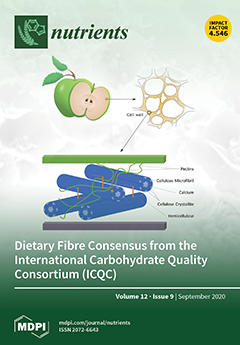To determine the effects of pre-sleep supplementation with a novel low glycemic index (LGI) carbohydrate (CHO) on next-morning substrate utilization, gastrointestinal distress (GID), and endurance running performance (5-km time-trial, TT). Using a double-blind, randomized, placebo (PLA) controlled, crossover design, trained participants (
n
[...] Read more.
To determine the effects of pre-sleep supplementation with a novel low glycemic index (LGI) carbohydrate (CHO) on next-morning substrate utilization, gastrointestinal distress (GID), and endurance running performance (5-km time-trial, TT). Using a double-blind, randomized, placebo (PLA) controlled, crossover design, trained participants (
n = 14; 28 ± 9 years, 8/6 male/female, 55 ± 7 mL/kg/min) consumed a LGI, high glycemic index (HGI), or 0 kcal PLA supplement ≥ 2 h after their last meal and <30 min prior to sleep. Upon arrival, resting energy expenditure (REE), substrate utilization, blood glucose, satiety, and GID were assessed. An incremental exercise test (IET) was performed at 55, 65, and 75% peak volume of oxygen consumption (VO
2peak) with GID, rating of perceived exertion (RPE) and substrate utilization recorded each stage. Finally, participants completed the 5-km TT. There were no differences in any baseline measure. During IET, CHO utilization tended to be greater with LGI (PLA, 56 ± 11; HGI, 60 ± 14; LGI, 63 ± 14%,
p = 0.16,
η2 = 0.14). GID was unaffected by supplementation at any point (
p > 0.05). Performance was also unaffected by supplement (PLA, 21.6 ± 9.5; HGI, 23.0 ± 7.8; LGI, 24.1 ± 4.5 min,
p = 0.94,
η2 = 0.01). Pre-sleep CHO supplementation did not affect next-morning resting metabolism, BG, GID, or 5-km TT performance. The trend towards higher CHO utilization during IET after pre-sleep LGI, suggests that such supplementation increases morning CHO availability.
Full article






